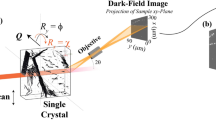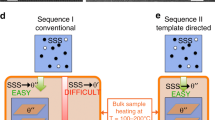Abstract
WE have recently made a study of the effect of heat treatment on silicon crystals containing up to 1017 aluminium atoms/c.c. After heating for several hours at a temperature of 1,250° C., transmission infra-red microscopy reveals the presence of a precipitated second phase within the crystals. In samples free of dislocations, these precipitates are needle-shaped and located at random sites, whereas in crystals with a dislocation density between 103 and 104 cm.−2, the precipitation occurs almost entirely along the dislocation lines. These latter precipitates invariably appear as discrete particles strung out along the lines (Fig. 1).
This is a preview of subscription content, access via your institution
Access options
Subscribe to this journal
Receive 51 print issues and online access
$199.00 per year
only $3.90 per issue
Buy this article
- Purchase on Springer Link
- Instant access to full article PDF
Prices may be subject to local taxes which are calculated during checkout
Similar content being viewed by others
References
Bilby, B. A., J. Iron and Steel Inst., 184, 65 (1956) (discussion).
Dahl, von W., and Lücke, K., Arch. Eisenhüttenw., 25, 241 (1954).
Bullough, R., and Newman, R. C., Proc. Roy. Soc., A (in the press).
Cottrell, A. H., “Dislocations and Plastic Flow in Crystals”, 134 (Oxford University Press, 1953).
Dash, W. C., J. App. Phys., 27, 1193 (1956).
Author information
Authors and Affiliations
Rights and permissions
About this article
Cite this article
BULLOUGH, R., NEWMAN, R., WAKEFIELD, J. et al. Precipitation on a Dislocation. Nature 183, 34–35 (1959). https://doi.org/10.1038/183034a0
Issue Date:
DOI: https://doi.org/10.1038/183034a0
Comments
By submitting a comment you agree to abide by our Terms and Community Guidelines. If you find something abusive or that does not comply with our terms or guidelines please flag it as inappropriate.



